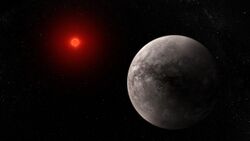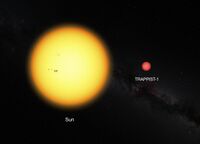Astronomy:TRAPPIST-1b
 Earth and TRAPPIST-1b compared | |
| Discovery[1] | |
|---|---|
| Discovered by | Michaël Gillon et al. |
| Discovery site | TRAPPIST |
| Discovery date | May 2, 2016 |
| Transit | |
| Orbital characteristics[4] | |
| 0.01154 ± 0.00010 AU (1,726,000 ± 15,000 km) | |
| Eccentricity | 0.00622±0.00304[2] |
| Orbital period | 1.510826 ± 0.000006 d (36.25982 ± 0.00014 h) |
| Inclination | 89.728°±0.165° |
| 336.86°±34.24°[2] | |
| Star | TRAPPIST-1[3] |
| Physical characteristics[4] | |
| Mean radius | 1.116+0.014 −0.012 R🜨 |
| Mass | 1.374±0.069 M🜨 |
| Mean density | 5.425+0.265 −0.272 g/cm3 |
| 1.102±0.052 g 10.80±0.51 m/s2 | |
| Albedo | 0.02±0.11[5] |
| Physics | 397.6±3.8 K (124.5 °C; 256.0 °F, equilibrium)[6] 503+26 −27 K (230 °C; 446 °F, surface)[7] |
| Atmosphere | |
| Composition by volume | None or extremely thin[7][8] |
TRAPPIST-1b, also designated as 2MASS J23062928-0502285 b, is a mainly rocky exoplanet orbiting around the ultra-cool dwarf star TRAPPIST-1, located 40.7 light-years (12.5 parsecs) away from Earth in the constellation of Aquarius. The planet was detected using the transit method, where a planet dims the host star's light as it passes in front of it. It was first announced on May 2, 2016,[1] and later studies were able to refine its physical parameters.
The planet is about 37% more massive than Earth and about 39% larger in volume; thus its density is very similar. It is the innermost of seven planets orbiting TRAPPIST-1, all of which are terrestrial, but is too close to its star to be in the habitable zone. Observations by the James Webb Space Telescope announced in 2023 suggest that it does not have any significant atmosphere.[7][8] Its albedo is very low, making it dark in color.
Physical characteristics
Mass, radius, and temperature
TRAPPIST-1b is very similar in both mass, radius, and gravity to Earth. It has a radius of 1.116 R🜨, a mass of 1.374 M🜨, and about 110% Earth's surface gravity.[4] Initial estimates of the planet's density suggested that it is not entirely rocky; with a density of 3.98 g/cm3, about ≤5% of its mass must be volatiles, likely in the form of a thick Venus-like atmosphere due to it receiving nearly four times more energy than Earth does.[2] However, refined density estimates show that the planet is only slightly less dense than Earth.[4]
Assuming the presence of an atmosphere, the planet's surface temperature was initially estimated to be between 750 K (477 °C; 890 °F) and 1,500 K (1,230 °C; 2,240 °F), potentially as high as 2,000 K (1,730 °C; 3,140 °F). This is much hotter than the surface of Venus and may be hot enough that the surface is molten lava.[2] An observation of the secondary eclipse of TRAPPIST-1b by the James Webb Space Telescope, announced in 2023, suggests that the planet does not have any significant atmosphere, with a measured surface temperature of about 503 K (230 °C; 446 °F),[7][8] and a low albedo.[5] The planet may be very geologically active due to tidal squeezing similar to Jupiter's moon Io, which happens to have a similar orbital period and eccentricity (see TRAPPIST-1 for references).
Orbit
TRAPPIST-1b orbits very close to its parent star. One orbit requires only 36 hours, or about 1.51 Earth days.[9] It orbits about 0.0115 astronomical unit|AU (1.72 million km; 1.07 million mi) from its star, just 1.2% the distance between Earth and the Sun.[2] The close proximity to its host star means that TRAPPIST-1b is likely tidally locked. It also has a very circular orbit, with an eccentricity of 0.00622, significantly more circular than Earth's orbit, which has an eccentricity of 0.0167086.
Host star
TRAPPIST-1b orbits the ultracool red dwarf star TRAPPIST-1. It has a mass of 0.089 M☉ and is only 0.121 R☉, with a surface temperature of 2,511 K (2,238 °C; 4,060 °F) and an age between 3 and 8 billion years. The Sun, in comparison, has a surface temperature of 5,778 K (5,505 °C; 9,941 °F) and is about 4.5 billion years old. TRAPPIST-1 is also very dim, with a luminosity about 0.0005 times that of the Sun. It is too faint to be seen with the naked eye, having an apparent magnitude of 18.80.
Atmosphere

The combined transmission spectra of TRAPPIST-1 b and c rule out cloud-free hydrogen-dominated atmospheres for both planets, so they are unlikely to harbor extended gas envelopes. Also, no helium emission from TRAPPIST-1b has been detected.[10] Prior to JWST observations, other atmospheres, from a cloud-free water-vapor atmosphere to a Venus-like atmosphere, remained consistent with the featureless spectra.[11]
In 2018, the planet's atmosphere was better examined by the Spitzer Space Telescope and suggested to be quite large and hot, although the presence of an atmosphere could not be confirmed. The planet's transmission spectrum and refined density estimate suggested two main possibilities for the atmosphere: one rich in carbon dioxide, or one rich in water vapor. The more likely CO2 atmosphere would have a scale height of approximately 52 kilometers (32 miles) (Earth's being 8 km (5.0 mi), and Venus' at 15.9 km (9.9 mi)) and an average temperature in excess of 1,400 K (1,130 °C; 2,060 °F), far greater than the planet's equilibrium temperature of 397.6 K (124.5 °C; 256.0 °F). A water vapor atmosphere would need to have a scale height of >100 km (62 mi) and a temperature >1,800 K (1,530 °C; 2,780 °F) to produce the variations seen in the planet's transit depths and its transmission spectrum, and would be vulnerable to photodissociation where CO2 would not be. Other sources for the effects seen, such as hazes and thick clouds, would require an even larger atmosphere. TRAPPIST-1b will have to be studied further to confirm its potential large atmosphere.[9][2]
An observation of the secondary eclipse of TRAPPIST-1b by the James Webb Space Telescope, announced in March 2023, suggests that the planet does not have any significant atmosphere.[7][8] Atmospheres containing carbon dioxide with surface pressures greater than 0.1 bar can be ruled out at 3-sigma, and pressures greater than 0.01 bar at 1-sigma.[5] Further studies of the exoplanet by transmission spectroscopy (primary eclipse), reported in September 2023, also confirmed the absence of a hydrogen-rich atmosphere, but due to stellar contamination were unable to determine the presence or absence of other types of atmospheres based on the transmission spectroscopy data alone. This does not affect the previous results based on emission spectroscopy.[12][13]
Gallery
-
Artist's view of planets transiting red dwarf star in TRAPPIST-1 system[14]
-
The Sun and the ultracool dwarf star TRAPPIST-1 to scale. The faint star has only 11% of the diameter of the Sun and is much redder in colour.
-
Artist's impression of three of the planets (b, c, and d) orbiting TRAPPIST-1
-
Artist's impression video, near one of the three planets orbiting TRAPPIST-1. One of the inner planets is shown in transit across the disc of its tiny and dim parent star.
See also
- 55 Cancri e, a very hot planet with a confirmed atmosphere.
- LHS 3844 b, a hot, rocky planet without an atmosphere
References
- ↑ 1.0 1.1 Gillon, Michaël; Jehin, Emmanuël; Lederer, Susan M.; Delrez, Laetitia et al. (May 2016). "Temperate Earth-sized planets transiting a nearby ultracool dwarf star" (in en). Nature 533 (7602): 221–224. doi:10.1038/nature17448. ISSN 1476-4687. PMID 27135924. Bibcode: 2016Natur.533..221G.
- ↑ 2.0 2.1 2.2 2.3 2.4 2.5 Grimm, Simon L.; Demory, Brice-Olivier; Gillon, Michael; Dorn, Caroline; Agol, Eric; Burdanov, Artem; Delrez, Laetitia; Sestovic, Marko et al. (2018). "The nature of the TRAPPIST-1 exoplanets". Astronomy & Astrophysics 613: A68. doi:10.1051/0004-6361/201732233. Bibcode: 2018A&A...613A..68G.
- ↑ Van Grootel, Valerie; Fernandes, Catarina S.; Gillon, Michaël; Jehin, Emmanuel; Scuflaire, Richard et al. (2018). "Stellar parameters for TRAPPIST-1". The Astrophysical Journal 853 (1): 30. doi:10.3847/1538-4357/aaa023. Bibcode: 2018ApJ...853...30V.
- ↑ 4.0 4.1 4.2 4.3 Agol, Eric; Dorn, Caroline; Grimm, Simon L.; Turbet, Martin et al. (1 February 2021). "Refining the Transit-timing and Photometric Analysis of TRAPPIST-1: Masses, Radii, Densities, Dynamics, and Ephemerides" (in en). The Planetary Science Journal 2 (1): 1. doi:10.3847/psj/abd022. Bibcode: 2021PSJ.....2....1A.
- ↑ 5.0 5.1 5.2 Ih, Jegug; Kempton, Eliza M.-R.; Whittaker, Emily A.; Lessard, Madeline (May 2023). "Constraining the Thickness of the Atmosphere of TRAPPIST-1 b from its JWST Secondary Eclipse Observation". The Astrophysical Journal Letters 952 (1): L4. doi:10.3847/2041-8213/ace03b. Bibcode: 2023ApJ...952L...4I.
- ↑ Ducrot, E.; Gillon, M.; Delrez, L.; Agol, E. et al. (1 August 2020). "TRAPPIST-1: Global results of the Spitzer Exploration Science Program Red Worlds" (in en). Astronomy & Astrophysics 640: A112. doi:10.1051/0004-6361/201937392. ISSN 0004-6361. Bibcode: 2020A&A...640A.112D.
- ↑ 7.0 7.1 7.2 7.3 7.4 Greene, Thomas P.; Bell, Taylor J.; Ducrot, Elsa; Dyrek, Achrène; Lagage, Pierre-Olivier; Fortney, Jonathan J. (March 2023). "Thermal Emission from the Earth-sized Exoplanet TRAPPIST-1 b using JWST". Nature 618 (7963): 39–42. doi:10.1038/s41586-023-05951-7. PMID 36972683. Bibcode: 2023Natur.618...39G.
- ↑ 8.0 8.1 8.2 8.3 "NASA's Webb Measures the Temperature of a Rocky Exoplanet". STScI. 27 March 2023. https://webbtelescope.org/contents/news-releases/2023/news-2023-110.
- ↑ 9.0 9.1 Delrez, Laetitia; Gillon, Michael; H.M.J, Amaury; Brice-Oliver Demory, Triaud; de Wit, Julien; Ingalls, James; Agol, Eric; Bolmont, Emeline et al. (2018). "Early 2017 observations of TRAPPIST-1 with Spitzer". Monthly Notices of the Royal Astronomical Society 475 (3): 3577–3597. doi:10.1093/mnras/sty051. Bibcode: 2018MNRAS.475.3577D.
- ↑ Krishnamurthy, Vigneshwaran et al. (2021), "Nondetection of Helium in the Upper Atmospheres of TRAPPIST-1b, e, and F", The Astronomical Journal 162 (3): 82, doi:10.3847/1538-3881/ac0d57, Bibcode: 2021AJ....162...82K
- ↑ de Wit, Julien (2016). "A combined transmission spectrum of the Earth-sized exoplanets TRAPPIST-1 b and c". Nature 537 (7618): 69–72. doi:10.1038/nature18641. PMID 27437572. Bibcode: 2016Natur.537...69D.
- ↑ Sherburne, Morgan (25 September 2023). "James Webb Space Telescope's first spectrum of a TRAPPIST-1 planet". Phys.org. Archived from the original on 29 September 2023. https://archive.today/20230929124619/https://phys.org/news/2023-09-james-webb-space-telescope-spectrum.html. Retrieved 29 September 2023.
- ↑ Lim, Olivia (22 September 2023). "Atmospheric Reconnaissance of TRAPPIST-1 b with JWST/NIRISS: Evidence for Strong Stellar Contamination in the Transmission Spectra". The Astrophysical Journal Letters 95 (1): L22. doi:10.3847/2041-8213/acf7c4. Bibcode: 2023ApJ...955L..22L.
- ↑ "Artist's view of planets transiting red dwarf star in TRAPPIST-1 system". http://www.spacetelescope.org/images/opo1627a/.
 |
![Artist's view of planets transiting red dwarf star in TRAPPIST-1 system[14]](/wiki/images/thumb/5/50/Artist%27s_view_of_planets_transiting_red_dwarf_star_in_TRAPPIST-1_system.jpg/200px-Artist%27s_view_of_planets_transiting_red_dwarf_star_in_TRAPPIST-1_system.jpg)








